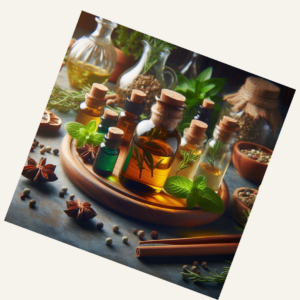Aromatherapy sprays are a type of therapeutic spray that uses essential oils combined with a solvent, usually alcohol or witch hazel, to create a fine mist. These sprays are primarily used for their energetic and aromatic benefits, and they can be sprayed into the air, on objects, or around the environment to cleanse and uplift the atmosphere. While they are not applied directly to the skin, the essential oils in these sprays still interact with the senses through inhalation and energetic influence.
Benefits of Aromatherapy Sprays:
- Energetic Hygiene: These sprays can clear negative or stagnant energy in a room, area, or on objects, such as crystals or personal items. Essential oils with cleansing properties like sage, cedarwood, or frankincense are often used for this purpose.
- Air Purification: Essential oils like eucalyptus, tea tree, or lemon have natural antibacterial, antiviral, and antifungal properties, which help purify the air.
- Mood Enhancement: Essential oils can promote emotional well-being. For example, lavender and chamomile can create a calming atmosphere, while peppermint and citrus oils can energize and uplift.
- Cleansing: The alcohol base, combined with essential oils, provides a cleansing effect on the energetic level, helping to clear out unwanted or stuck energy from spaces, objects, or even before meditation or spiritual work.
How to Make and Use Aromatherapy Sprays
Materials Needed:
- Essential oils: Choose oils based on your purpose (e.g., sage, frankincense, lavender, tea tree).
- Alcohol: Use a neutral high-proof alcohol like vodka (preferably 70-90% alcohol) or witch hazel. Alcohol helps disperse the essential oils more evenly and also has a natural cleansing effect.
- Spray bottle: a pump spray bottle
- Optional: Distilled water can be added in small amounts, but alcohol should be the main base.
Instructions:
- Prepare Your Ingredients:
- For every ounce (30 mL) of alcohol, add 10-15 drops of essential oil. This can vary slightly depending on the strength of the oils and the size of the bottle.
- Essential oils to use:
- Frankincense: For spiritual cleansing and grounding.
- Sage or Palo Santo: For energetic clearing.
- Tea Tree or Lemon: For purifying and uplifting.
- Lavender: For relaxation and calming energy.
- Peppermint or Eucalyptus: For stimulating and refreshing energy.
- Add Alcohol:
- Add the alcohol to your spray bottle. Alcohol acts as the solvent, helping to dissolve and evenly disperse the essential oils.
- Add Essential Oils:
- Drop 10-15 drops of essential oil into the alcohol. You can adjust the amount depending on your personal preference for scent strength or therapeutic effect.
- Shake Well:
- Shake the bottle gently to mix the alcohol and essential oils thoroughly. Since essential oils don’t dissolve completely in water or alcohol, shaking the bottle each time before use helps distribute the oils evenly.
- Use the Spray:
- Energetic Hygiene: Spray in the air, around your aura, or in spaces that need energetic clearing (e.g., around your workspace, home, or meditation area). You can also use it to mist objects such as crystals, jewelry, or tools for cleansing.
- Room Spray: Mist the air in a room to purify the air and create a desired atmosphere, whether calming, energizing, or cleansing.
- Object Cleansing: Spray on items or areas that may hold negative or stagnant energy, like a room after an argument, or personal items that need cleansing.
- Storage:
- Keep the aromatherapy spray in a cool, dark place to preserve the efficacy of the essential oils.
- Why Alcohol Over Water?
- Alcohol as a Solvent: Alcohol is an effective solvent for essential oils, allowing them to blend more easily and evenly into the spray mixture. It helps distribute the oils in the spray without them separating or floating on top.
- Cleansing Properties: Alcohol has a natural cleansing effect. It can purify both the air and energetic environment, making it ideal for energetic hygiene sprays. Unlike water, alcohol also evaporates quickly, leaving behind the pure scent and energy of the essential oils.
- No Risk of Mold: Water-based sprays, if not used immediately, can develop mold or bacteria due to the moisture. Alcohol-based sprays do not carry that risk.
Caution and Tips:
- Sensitizing Oils: Some essential oils can be caustic or sensitizing (e.g., citrus oils, tea tree, oregano, or cinnamon). When using oils like these in an aromatherapy spray, avoid direct contact with the skin. Spraying in the air or on objects is a safer option, as it prevents potential irritation.
- Patch Test: If you plan to use the spray on your body or sensitive areas, always perform a patch test on a small area of skin before widespread use.
- Avoid Eyes and Mucous Membranes: Never spray directly into the eyes, nose, or mucous membranes. Keep the spray at a safe distance when using around the face.
- Sensitivity: Be mindful of people with respiratory issues (e.g., asthma) when using sprays, as strong aromas can sometimes be overwhelming or cause irritation.
Aromatherapy sprays are a powerful tool for energetic hygiene and emotional well-being. By using essential oils in combination with alcohol, you can create sprays that cleanse spaces, purify the air, and promote a desired atmosphere. These sprays are especially effective for clearing energy, enhancing mood, or preparing for spiritual or meditative practices, while also offering the cleansing and therapeutic benefits of essential oils. Just be sure to use the appropriate oils, avoid those that are sensitizing or caustic, and store the sprays properly to maintain their effectiveness.
Spray is one of the many methods of using essential oils.
